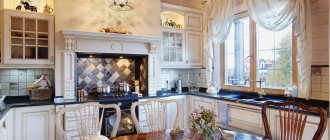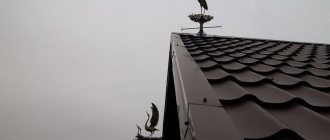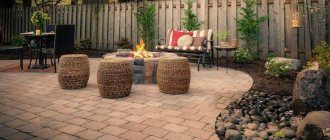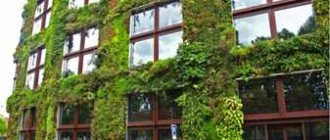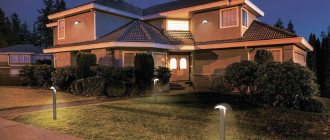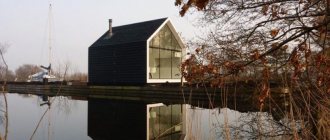A weather vane is a meteorological device installed on a roof to determine the direction and strength of the wind. Originally a functional attribute that sways from side to side, today it has become a striking decorative transformation, decorating the roofs of houses.
Purpose and principle of operation
The compact flag rotates around an axis due to gusts of air. The design simultaneously plays a practical and decorative role. Previously, the device was used to measure wind force, then it became an original roof decoration.
What is a weather vane
A weather vane is a simple meteorological instrument that, under the influence of air, rotates in the direction of less resistance. The design clearly shows the strength and direction of the wind. The device protects the chimney from gusts and prevents smog from returning to the home.
Design with a dog Source orgpage.ru
Traditionally, weather vanes were installed on the roofs of houses in Europe. A memorable detail was rarely repeated, so each home became original. The elements visually emphasized the type of activity of the property owners or had a protective function.
Components
The design of the weather vane consists of mandatory parts. A flag is a memorable, decorative part of the device, which is placed on a vertical axis. To balance the weather vane, a counterweight is needed on the opposite side. The elements have the same mass, so they stand level when installed.
The body is used as a support for the weather vane. The vertical axis of the structure is installed in the frame. The supporting rod (mast) holds the weight of the decorative part and does not break in strong winds. Bearings (balls, cylinders) inside the device ensure free rotation.
What does a windmill consist of Source build-experts.ru
The protective cap is made in the shape of a cone or sphere and is placed above the frame. The task of the element is to protect the housing and moving parts from moisture and debris. To fix the device on the roof, use the following fasteners:
- corners;
- overlays;
- bottles;
- nuts
The wind rose is an indicator of the cardinal directions, which is attached under the flag. The part consists of two even rods connected at right angles. Rumbas with letter symbols are mounted on the 4 ends. The wind speed will be determined by a propeller made from plates. Modern devices additionally install electronic sensors (encoders).
Types of structures
The choice of weather vane design depends on the role that the device will play. Functionality is divided into 6 types:
- Anemorummeters. Meteorological models measure wind speed and direction. Professional devices have power supplies and sensors that convert air characteristics into signals. They record accurate readings and transmit the data to the equipment via cable.
- Wild weather vanes. Mechanical structures for measuring wind direction and strength at home. Additionally they have a decorative function.
- Chimneys. Mounted above the hole, blocking access to the wind. By rotating the device, they prevent backdraft in the pipe and protect the room from the penetration of combustion products.
- Scarecrow. Weather vanes make unpleasant sounds that scare away birds from nesting in pipes or landing on the site.
- From rodents. Devices with a propeller are mounted in the ground on a support. The rotating fan blades create vibrations that are transmitted into the soil and drive away mice, shrews and moles.
- Power plants. During operation, wind vanes generate electricity.
Professional anemorummeter Source ru.lifehackk.com
The devices are installed on the canopy of the house, on the roof of the veranda or gazebo. Often designs combine 2-3 functions, saving space on the roof. Bird repellent options are mounted on a pipe or trees. It is recommended to place several devices against rodents in different places of the site (along the perimeter, in the center).
Model for a pipe hole Source odymohodah.ru
Weather vane-scarecrow from birds Source m-dachnik.com
Installation of a homemade weather vane
Installation of a wind indicator on the roof is carried out in stages:
- The flagpole (axis of rotation) is secured to the roof ridge or other preferred location using clamps or the provided mounting plate with screws.
- A ball is placed inside the silhouette tube. It is a kind of hinge for rotation. In order for the rotating wind indicator to respond better to the air flow, the ball should be lubricated with grease or other lubricant.
- The silhouette is put on the axis of rotation. The homemade flagpole is ready for use.
Symbolic meaning
Movable figures on the roof not only helped to determine the direction of the wind or scare away birds, but also carried a semantic load. The device decorated and served as a talisman. Before you make a weather vane at home, you need to understand the meaning of the symbols.
Rooster
The traditional model was popular not only in Western Europe, but also in Rus'. The bird wakes up first, screaming to announce the dawn. According to popular beliefs, the image protected residents from danger and warned of approaching enemies. A weather vane in the shape of a rooster protected the house from fires and robbers.
Bird on a weather vane Source arno-group.ru
Stork
The model was popular in Scandinavia. Feathers were considered a symbol of happiness, comfort and renewal of generations. The design in the form of one bird called love, success and prosperity into the house. Families wanting children installed a windmill in the shape of two storks.
Beautiful design Source eurofluger.ru
Swans
The weather vane consisted of a pair of birds that swam or flew towards each other. Swans were a sign of marital fidelity, wisdom and mutual support. Birds were considered a symbol of natural beauty, chastity and personified great love.
A pair of birds on a weather vane Source livemaster.ru
Angel or Christian saint
The design is often used by believers. The figurine of an angel on a weather vane means spiritual closeness and a symbol of true faith. St. George the Victorious will protect from evil and enemies. If there are small children in the house, then the image of St. Nicholas will bring peace and kindness to the home.
Cat and dog
The animal symbolizes the desire for freedom, love for independence. Cats have 7 lives, which they will devote to protecting their family until the seventh generation. A pet simultaneously lives in the world of people and spirits, so it will protect its residents from envious eyes and otherworldly interference.
Windmill with animals Source fotokto.ru
The dog symbolizes devotion and fidelity. The dog has excellent eyesight and sense of smell. The animal vigilantly monitors everything that happens in its visibility zone. The figure on the roof will recognize visitors with bad thoughts and will drive them away from the threshold.
The Dragon
In Europe, the mythical animal was present on the coats of arms of nobles and symbolized victory over enemies. In China, the dragon brought success, financial well-being into the home and protected against illness. On the weather vane, the Western beast was depicted with wings and a pointed tail. The eastern species resembled a long snake with paws and a pearl in its mouth.
Mythical animal on a weather vane Source westcoastweathervanes.com
Knight
The figurine of an armed man is holding the flagpole. The symbol denoted courage, spiritual perfection and strength. By installing the structure on the roof, the residents of the house showed their readiness to protect the weak and oppressed.
Baba Yaga
The witch on the weather vane symbolizes knowledge, cunning and wisdom. In fairy tales, the character lives on the border of the world of the living and the dead, and does not allow evil to penetrate human lands. According to signs, Baba Yaga on the roof will protect against the evil eye, material losses and bring peace to the house.
Windmill with a witch Source 26.teplozhar.ru
Lion or bear
Proud animals symbolize courage, generosity and nobility. A lion figurine on a weather vane signifies the ability or desire to dominate others. The design with the bear will protect the residents of the house from losses and failures.
Eagle or owl
A huge bird with open wings is the embodiment of strength, intelligence and attention to others. The noble eagle on the weather vane became a protector from evil people and betrayal. Thanks to good eyesight, an owl will warn of an enemy who has entered the home.
Griffin
The mythical animal combines the features of an eagle and a lion. The winged beast signifies prosperity, wealth and power. The structure on the roof is installed by people who want to emphasize their high status and influence, so you should not mount the figurine on a tiny country house.
Mythical creature on a weather vane Source dinora.rf
Horse
The horse on the weather vane symbolizes strength, vitality and nobility. A powerful animal will give those living under the roof endurance, prudence and endurance. A man on a horse (rider) represents self-confidence.
sailboat
The frigate on the weather vane is a symbol of hope, determination and security. Windmills with sailboats were often installed by sailors who went ashore. The image of a ship will help to destroy the boundaries that hold back ambitions and desires.
Symbolism
Since ancient times, people have believed in the mystical power of amulets, and a weather vane on a chimney or roof of a house played, first of all, the role of a talisman for the house. In fact, the wind indicator was also a decoration that carried a certain magical protection.
Today, too, many will not refuse a good amulet, so when choosing a weather vane for the private sector in the city or for a summer residence, they often remember the symbolic load of this element.
Original weather vane on the roof
Let's look at some of them:
- According to the beliefs of ancestors, a weather vane made of metal or copper in the shape of a rooster drives away evil spirits from the house, protects the monastery from fires, robberies and any enemy attacks;
- Cow or horse figurines symbolize eternal love and devotion;
- The griffin is a symbol of power and prosperity. He should attract wealth and success to the house;
- The ship depicted on the weather vane will attract positive changes to the house;
- Freedom-loving and creative people choose a cat;
- Angel - protector of the house and its inhabitants, messenger of the spiritual world;
- Images of sorceresses or witches should indicate the strength and power of the person living in the house.
In fact, absolutely any sign, symbol or image can become the basis for creating an exclusive weather vane. One of the latest trends is to hang wrought iron weathervanes with the names of the residents of the house.
Weathervane with sailboat on the roof
Weather vane in the shape of a rooster
Material selection
Practicality and ease of processing - these are the main criteria when choosing raw materials for making a weather vane at home. The material must be beautiful, durable and low maintenance, otherwise the owner will have to frequently repair the structure. Among the popular ones there are 6 types.
Wood
Light, practical raw materials do not require a person to have complex skills and professional equipment. To create a weather vane at home, you can use larch and aspen. Coniferous species are quickly destroyed, oak is too hard. Before installation, the windmill is impregnated with compounds that protect against insects, moisture and drying out. To prevent moving parts from wearing out, a combination of wooden and metal elements is allowed in the design.
Wood for a weather vane Source volgograd-sp.ru
Composites
Plywood is made from pressed thin sheets of wood. For the manufacture of weather vanes at home, a multi-layer waterproof type, which is installed on an iron frame, is suitable. To increase service life, the structure is painted or coated with a transparent protective varnish.
Chip-based composite boards are very heavy and bulky. With constant exposure to moisture, the material is destroyed, and from the sun it dries out. It is difficult to cut intricate shapes from chipboard, so it is not suitable for creating weather vanes.
Steel
Strong raw materials are resistant to mechanical stress. To make windmills at home, alloy stainless steel is used, which is processed using special equipment. Tolerance to adverse weather will allow the metal structure to be used in rain and heat.
Metal weather vane Source ironvane.com
At home, you can assemble a simple model from wire or make a weather vane of complex shape. With proper and regular maintenance, the windmill will last for decades without deformation. More capricious black steel must be treated with an anti-corrosion compound before installation.
Copper
Resistant, durable and ductile metal can withstand temperature changes, humidity and bright sun. Copper has a natural resistance to corrosion, so at home the structure does not need to be further protected. A weather vane made of practical material “ages”, acquiring an expensive, beautiful appearance.
Metal option Source e-pard.com
Design options
When making your choice, you need to be guided by several important parameters:
- the weather vane must have a symbolic image;
- the entire composition as a whole must correspond to the architecture of the house;
- the weather vane should become a decoration of the roof.
It doesn’t matter whether you make a weather vane yourself or order it from craftsmen, the main thing is that you like it, it’s made with soul and looks impressive on the roof. There are many options for execution. First of all, the figurine itself is discussed. It is a symbol and at the same time a flag that turns in accordance with the direction of the wind.
- The rooster is a talisman against evil forces;
- Griffin is a symbol of power;
- The stork symbolizes the beginning of a new life;
- Horse - friendliness;
- The ship - freedom and passion for travel.
In addition, it is important what the future flag will look like. It can be either a flat metal figurine or convex, but hollow inside. Those who don't mind spending money order weather vanes, which can be called a work of art. The material of manufacture is of great importance. It is most often used as:
- plastic;
- steel;
- tree;
- copper;
- stainless steel.
Copper weather vanes are considered the most durable and durable. They do not lose their beauty over time, are durable, and do not require complex care. Weather vanes made of steel are also quite popular and are somewhat cheaper than copper ones. Plastic and wooden ones are considered the least durable. In addition, plastic does not look so bright on the roof, due to which the romance of the composition is lost. Our article presents photos of interesting weather vane models.
Steel weather vane
From thick sheet steel (2-5 mm) you can make a weather vane that is strong and durable. When working with material, the craftsman must have skills, otherwise it will be difficult to cut out the desired design. Three-dimensional directional indicators are created from galvanization, which are then painted with automotive enamel.
Decorative details
A life-size weather vane flag stencil is fixed with double-sided tape on a steel sheet. The contour along the edge is applied at home using the punching method (pointwise). A strong awl or narrow chisel is placed with the tip on the drawing. Gently hit the handle with a hammer. You should get dents of the same size, along which the workpiece is processed with a jigsaw.
Having cut out one part of the weather vane, the sheet is turned over. At home, work slowly, trying to get smooth, straight edges. The figurine is processed with a grinding machine or cleaned with fine-grain paper.
Design Features
Modern stores sell classic types of weather vanes, made by stamping copper or steel sheets. The figurative part is decorated with images of animals or fairy-tale characters that have some symbolic meaning.
To ensure correct determination of wind direction, the structure is fixed on the roof according to technological rules, information about which is contained on many Internet sites. The standard weather vane structure contains three main elements.
Among them is found:
- A post used to hold all structural parts and secure them to the roof.
- A weather vane, which is a rotating element.
- A cardinal pointer that helps you notice the direction of blowing winds.
Wooden weather vane
The model drawing is attached to a wooden or plywood sheet. Using a pencil or marker, the drawing is transferred to the surface. If you do not have the skills to work with wood, it is better to choose a simple image without complex patterns. Treated with sandpaper:
- weather vane flag;
- arrow;
- compass rose elements.
Carefully assemble the parts. Craftsmen recommend using furniture glue as fasteners at home. The viscous mass will allow you to connect a structure of any complexity. The substance is applied along the edge, combining the components. To avoid unsightly marks, drips must be removed with a damp cloth or sponge.
The base is made of a wooden block made in the shape of a square or rectangle. A hole is drilled in the middle of the part into which a nail is inserted. At home, small beads or metal balls are used as bearings in the turning mechanism.
Wooden version Source livemaster.ru
After assembling the structure, the wooden surfaces are coated with moisture-repellent and protective compounds. A weather vane made of wood can be painted with latex or oil enamel at home. Using brushes, they create a complex multi-colored design with many details and small patterns.
Working with wood
A weather vane made of wood looks very cozy and beautiful, but disappoints with its too short period of use. Of course, the product can also be treated with special protective compounds, but they will not solve the problem for long.
A wooden weather vane is constantly exposed to precipitation, sudden changes in humidity and temperature. No type of wood can withstand such loads for a long time. However, if there are pieces of plywood lying around the house, they can be used for home crafts, updating the design of the roof of the house from time to time.
Traditional weather vane
Weather vane in the form of a raven
Often, plywood and other types of wood that are easy to process are used as improvised materials for teaching children. Together you can make different figures that will rotate. They are painted, varnished and placed on the chimney.
Such crafts can be made into a good family tradition: create new creations every year and decorate your home with them. In addition, we should not forget about the symbolism of the weather vane. Each time a rotating figurine can represent a new stage of life and call something good into the house, especially needed at that particular moment.
Weather vane with figure of a horseman
Weather vane made of plastic
The main task of a weather vane is to indicate the direction of the wind. At home, it is easy to create a model of any complexity from a practical polymer. A homemade windmill will harmoniously fit into the design of the roof, garden and site.
Propeller
A plastic weather vane is a practical design that can be easily made at home. To make the model you will need polymer sheets of different colors. The drawing is fixed to the material using double-sided tape. The contours of the drawing are drawn on the surface with a marker. Using scissors, carefully cut out the figures along the lines.
If the model is simple, then the parts are glued together with hot glue. The silicone compound from the gun dries quickly and bonds small components well. For large windmills, the propeller is fixed with a self-tapping screw and a decorative cap is put on top.
Polymer model Source YouTube.com
Plastic is very light, so when creating a weather vane at home, weights are used. The body is assembled from metal pipes. The mobility of the structure will be ensured by a bearing or a small ball, which is placed between the parts.
Wheel
At home, you can easily make a weather vane repeller for birds and rodents from plastic bottles and the remains of an old bicycle. The design can combine small and large containers. Multi-colored tanks rotate to create a bright rainbow effect. The knitting needles are tinted with varnish or enamel.
The drawing is made on a piece of wallpaper or whatman paper, taking into account the diameter of the wheel and the number of blades. Transfer the schematic drawing to the bicycle part. Points are placed at the connection points, holes are drilled and bolts with bottle caps (threaded outwards) are inserted.
Repeller for the site Source eco-officegals.com
Containers are screwed onto the wheel, alternating large and small volumes. To improve the torsion of the weather vane, the bottom of large cylinders can be cut off. The blades point in the same direction and move evenly. The holder for the structure is made from a pipe or a wooden block.
Yula
A decorative garden weather vane is easy to make from plastic. At home, use a two-liter bottle. The cylinder is cut into 2 parts, a hole is punched in the center of the bottom and lid with a metal rod. The hot iron melts the polymer, so the holes have smooth edges. The structure must move freely around its axis.
On the upper and lower half of the bottle, cut the fringe to the same length, leaving 5 cm to the edge. At home, it is better to use pruning shears or strong garden shears. After assembly, the weather vane resembles a children's toy spinning top. The strips are glued together with hot glue to create a three-dimensional structure.
For decoration, the windmill is painted with acrylic paints or nail polish. The model decorated with fragments of CDs looks impressive. In the sun, the weather vane creates bunnies, which, together with the rustling sound, will scare away the birds.
Do-it-yourself weather vane on the roof
You can even make a weather vane with your own hands, using more primitive materials: wood, plywood, plastic. Traditionally, metal is used, which makes it possible to create products with a long service life. Copper blades can be coated with various anti-corrosion compounds that protect the weather vane from ultraviolet radiation and moisture. Every master uses this liquid in his work. When creating decorations with your own hands, it is also recommended to use anti-corrosion agents. With the help of special scissors you can easily cut out any shape or symbol. The speed of work depends on basic skills. Before starting work, it is better to draw a sketch, according to which the creation of a weather vane will be even more simplified. The most advanced technology is laser cutting, which allows you to create real masterpieces. However, this method is also the most expensive in terms of finances.
Making your own weather vane can become a good family tradition: making new creations every year and decorating your home with them. In addition, do not forget about the symbolism of the weather vane. A spinning character can represent a new stage in life and invite something good into the home.
How to install a weather vane
The structure must catch the wind and move at the slightest gust. To prevent the device from becoming a useless decoration, it must be installed correctly. A weather vane made of any material is installed at the highest point of the building. The windmill is placed on the chimney, ridge (spire) or ventilation of the house, on the roof of the gazebo and greenhouse.
In order for the weather vane to catch wind currents, at home the structure is raised to a height of 4-5 m. To correctly determine the cardinal directions, check the position of the device using a building level. The wind rose is set using a compass or a map from the navigation application. The force of the air is determined by a suspension made of steel or plywood, which is suspended from the arrow of the flag.
Installation of the structure Source remontbp.com
To mount the weather vane on the roof, fasteners are used. At a hardware store you can buy metal corners to fix the structure. If you need to adjust the vertical position of the windmill, it is better to purchase fasteners with screws. The device is rigidly installed on the base, otherwise it makes noise and vibrates when moving.
Heavy steel and copper structures are mounted on metal strips. The base is welded or fixed using brackets. The weather vane can be turned into a lightning rod. An iron wire is attached to the fixed parts, the lower end of which is buried to a depth of 1.5 m.
Main materials of manufacture
Forged metal is traditionally used to produce classic weather vanes, while wood and more durable polyvinyl chloride materials are used for display products. Metal products are distinguished by their most simplified design.
Skilled craftsmen decorate the workpiece with some kind of animal. It is attached to a metal rod, the lower end of which is fixed to the roof of a private building. The dimensions of the decorative part vary from 40 to 70 centimeters. Turning under the control of moving air, it shows the direction the wind is blowing.
In order for the weather vane on the house to function as correctly as possible, its mounting rod must be placed extremely vertically.
New Year's crafts from pine cones: decor ideas from pine cones for the New YearDecorative elements made of stone as an integral part of landscape design
Smartphone case: overview of the main types
Wooden identifiers are demonstration devices through which specialists teach children the names of the cardinal directions. After installation on the roof, the main material of the devices will quickly deteriorate under the influence of temperature, ultraviolet radiation and precipitation.
To make a wooden weather vane with your own hands, you need to cut out the main elements from a plywood board. Then they are covered with multi-colored paints, treated with deck varnish and assembled into a single structure. Varnish impregnation will protect the product from adverse factors for a short period of time.
